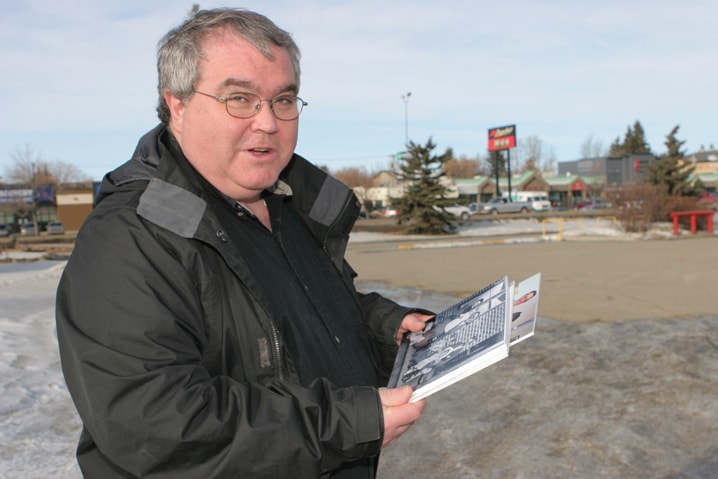A mischievous little boy, a serial arsonist and a missed train all played pivotal roles in shaping a town of 300 people into the city that Red Deer has become.
City historian Michael Dawe has been working for the last four years on projects celebrating the century that has passed since March 25, 1913, when Red Deer was incorporated as a city.
“The idea is not only just to say how Red Deer developed, but why; what’s unique about Red Deer and what are some of the factors that made it unique,” says Dawe.
A figure who looms large but who has been largely forgotten is John T. Moore, a chartered accountant and former Toronto city councillor — and no relation to the owners of Northwest Motors.
Appointed managing director of the Saskatchewan Land and Holding Co., Moore had travelled west to the end of the rails and then kept on going. He found himself above the banks of Waskasoo Creek at what is now Rotary Park, viewing the valley from the peak of Piper’s Mountain at unclaimed land that he felt had terrific farming potential.
He convinced his employer to purchase 180 sections of land in the immediate area from the federal government, effectively ensuring that homesteaders would have to go elsewhere to stake their claims.
It was only after all of the homestead land was taken up that people started buying land in what would be Red Deer. That process limited Red Deer’s growth while other towns, like Innisfail and Lacombe, were booming, says Dawe.
After sewing up the land deal, Moore convinced a retired and ailing minister, Rev. Leonard Gaetz, to uproot his family from their home in Hamilton, Ont. and come west as land agent for the Saskatchewan Land and Holding Co.
Gaetz became a local legend and was eventually immortalized in bronze on a bench at the corner of Ross Street and Gaetz Avenue.
Another entrepreneur from back east was also looking for a new start in the west and was interested in checking out the sites available at Lacombe.
However, James Bower ended up stranded in Red Deer after missing his train and decided to take a closer look at the local opportunities.
He went to the Saskatchewan Land and Holding Co. to see what was for sale and found a site that Moore had been keeping for himself. However, Moore was out of town and the agent acting on his behalf cut a deal with Bower for the site that would become Sunnybrook Farm.
The Moores and Bowers crossed paths again in August of 1910, when Moore invited Canadian Prime Minister Sir Wilfred Laurier to drive the first spike for the Alberta Central Railway, to run from Red Deer to Rocky Mountain House.
The day before the planned event, Bower’s son, Hugh encountered the setup on his way to school. He picked up a mallet and pounded in a few spikes before skipping happily off to class.
Organizers who discovered the hijinks feared an attempt at sabotage and posted an armed guard.
Hugh’s father, president of the United Farmers of Alberta at the time, had written a speech for the occasion.
James Bower was so nervous, he started to have a heart attack while delivering his speech, but insisted on finishing and was then taken immediately to hospital.
He never fully recovered, says Dawe.
It was only after the Saskatchewan Land and Holding Company was foreclosed by heirs of an investor that Moore’s true colours started to bleed through.
He was hauled into court, accused of various shady deals and deeds. The judge ruled, however, that while Moore had certainly bent the rules, none had been broken, says Dawe.
In a separate chapter Dawe describes a wave of terror that coursed through the city during 1969 and 1970.
People were frighened and police were baffled when a series of fires broke out along 48th Ave., including destruction of Phil’s Pancake House and damage to the South School.
The only person ever injured was the man who had started the fires, says Dawe.
The arsonist burned his own hands while lighting fire to the Sacred Heart Church, giving police the evidence they needed to crack the case, says Dawe.
On the morning after, police found Skip Lawlor, 19, trying to relieve his pain in the cool waters of the Red Deer River.
Lawlor was convicted of several counts of arson, but was never charged with a fire that occurred at about the same time at the Eastview school, says Dawe.
The court didn’t believe his confession to that fire because it didn’t fit the pattern he had established with the others.
Dawe says his research delves into a wide range of themes that contributed to the shape Red Deer has taken during that past 100 years.
“It’s not meant to be sort of a chronology of Red Deer. It’s an attempt to tell not only what happened in Red Deer, but why.
For example, there’s one chapter called For God and Profit, and that’s the story of the Saskatchewan Land and Homestead Company.”
Estimated at about 300 pages including 400 to 500 pictures, Remarkable Red Deer should sell for about $35 per copy, said Dawe. His salary while working on the project has been covered jointly by the City of Red Deer and the Red Deer & District Museum and Art Gallery. Printing and publishing costs are to be borne by sales of the book, says Dawe.
bkossowan@www.reddeeradvocate.com
